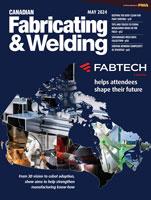Editor
- FMA
- The Fabricator
- FABTECH
- Canadian Metalworking
The time has come for reshoring, nearshoring
Pandemic, supply chain complications an ideal indication of the value of this shift
- By Rob Colman
- December 2, 2022
I recently had the opportunity to tour AMADA AMERICA’s Brea Manufacturing Facility in Brea, Calif., where the company builds its ENSIS 3015 AJ and 4020 fiber laser cutting systems for the U.S. and Mexico markets. The company’s new COO, Patrick Medlin, was on hand to discuss its push to increase its manufacturing footprint in North America.
The evidence of that push was most recently enhanced by the opening of its Carolina Manufacturing Center, High Point, N.C., in 2019, where it builds press brakes and laser automation.
Medlin noted that having these facilities helped cushion the blow of supply chain disruptions during the past couple years. Although it isn’t keeping the inventory of machines it normally would at the Brea facility, it’s back to running close to capacity in the production and shipment of lasers.
If a company needed encouragement to consider nearshoring or reshoring its manufacturing processes, this would be a perfect case study for its advantages. But AMADA needs no encouragement. It has seen the value.
“We currently have more than 500,000 sq. ft. of manufacturing capacity and we’re just getting started,” said Medlin.
The company also is championing the development of IIoT technologies at its Los Angeles Technical Center.
The message that these investments express is one that fabricators, of course, hope to get out to their customers and potential customers: The pandemic and the logistics and supply chain complications we’ve seen over the past few years are an ideal indication of the value of having a partner closer to home that can offer fabricated parts and engineering services.
The advantages of sourcing close to home is obvious to Canadian fabricators—they know the level of quality control and speed of delivery their shops can offer, whether their customers are in Canada or the U.S. Now is the perfect time to talk to those customers and ask what they struggled to source over the past few years and how high the price of certain products has risen. Suddenly, what they offer customers might be that much more clearly advantageous.
According to a BDC/Deloitte Economic Advisory study from early in the pandemic, machinery manufacturing has been a Canadian reshoring poster boy. The ratio of imports to domestic production has declined since 2010, while production, investment, and employment have all increased steadily. Most other sectors have lagged behind, including fabricated metal parts. But indicators suggest the fab industry is moving toward more reshoring. The study said that there had been declines in imports versus domestic production ratios over that decade, and moderate output and investment gains. Perhaps the experience of the past two years has pushed that further.
Having larger manufacturers demonstrate the value of a North American presence helps hammer home the point, though. The work can get done here, at a price advantageous for all involved.
subscribe now


Keep up to date with the latest news, events, and technology for all things metal from our pair of monthly magazines written specifically for Canadian manufacturers!
Start Your Free SubscriptionAbout the Author

Rob Colman
1154 Warden Avenue
Toronto, M1R 0A1 Canada
905-235-0471
Robert Colman has worked as a writer and editor for more than 25 years, covering the needs of a variety of trades. He has been dedicated to the metalworking industry for the past 13 years, serving as editor for Metalworking Production & Purchasing (MP&P) and, since January 2016, the editor of Canadian Fabricating & Welding. He graduated with a B.A. degree from McGill University and a Master’s degree from UBC.
- Industry Events
Automate 2024
- May 6 - 9, 2024
- Chicago, IL
ANCA Open House
- May 7 - 8, 2024
- Wixom, MI
17th annual Joint Open House
- May 8 - 9, 2024
- Oakville and Mississauga, ON Canada
MME Saskatoon
- May 28, 2024
- Saskatoon, SK Canada
CME's Health & Safety Symposium for Manufacturers
- May 29, 2024
- Mississauga, ON Canada




















